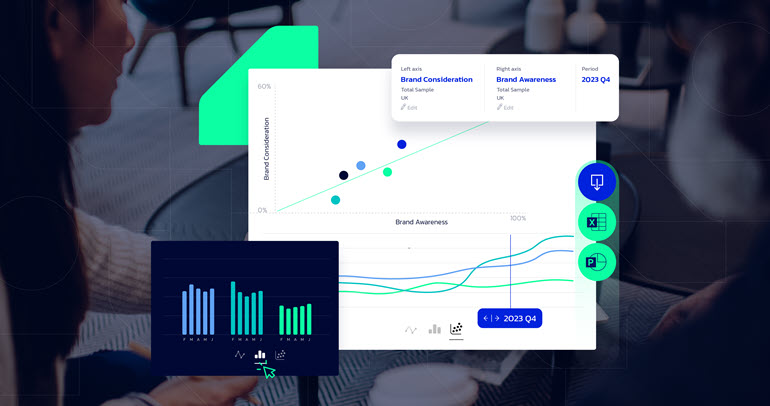
All-electric vehicles are gaining traction, but not everybody is ready to make the switch. While many new-car buyers see battery electric vehicles (BEVs) as the future, concerns around cost, charge time, range and battery life are still holding shoppers back.
In the meantime, electrified powertrains are helping to bridge the gap. Hybrid vehicles (HEVs), plug-in hybrid electric vehicles (PHEVs) and extended-range electric vehicles (EREVs) provide a middle ground between internal combustion engine (ICE) vehicles and fully-electric models. These options give buyers greater flexibility, offering environmental and cost-saving benefits without requiring buyers to give up on gas altogether. In other words, in the eyes of many shoppers, electrified powertrains represent the “best of both worlds”—at least until buyers are ready to commit to a BEV.
With alternative powertrains accounting for a growing portion of the market, original equipment manufacturers (OEMs) need a clear view of which buyers are open to which powertrains and why. Our recent EVForward® 2025 Non-BEV Alternative Powertrain DeepDive study explores how new-car buyers think about these “middle-ground” options. The report looks at which powertrains shoppers prefer, how well shoppers understand them and what role alternative powertrains might play in the path toward electrification.
Customer Satisfaction Doesn’t Equal Support for a Hybrid-Only Future
One powertrain pulling ahead of the rest is the HEV. HEV owners are overwhelmingly happy with their vehicles. Almost all (96%) say they are satisfied with the powertrain and three in four (73%) indicate they are glad they chose an HEV over a BEV.
However, despite HEVs’ broad popularity, consumers aren’t entirely on board with the idea of the hybrid as a default. When asked how they would feel if ICE vehicles were no longer an option and they had to buy a hybrid for their next vehicle, 39% of new-car buyers said they would not feel comfortable. The most common reaction among respondents to HEVs as the default powertrain was disapproval.
One factor that might force such a shift would be a spike in gas prices. Our findings reveal that the average ICE owner would be ready to move to an electrified offering if gas prices rose $1.80 from the price consumers were paying at the time of the study, from $3.70 to $5.50 per gallon. That said, even if prices were to rise, 34% of ICE owners reported they would never make the switch, regardless of the potential savings. It’s a reminder that, while ICE owners represent the largest accessible market for automakers looking for new alternative powertrain buyers, this group also includes some of the most EV-resistant consumers out there.
Familiarity Helps Hybrids; EREVs Need Explaining
Part of the reason EREVs aren’t as popular as hybrids comes down to familiarity. Hybrids have been around for more than 20 years. Consumers generally understand how the hybrid powertrain works. And thanks to Toyota’s long-time leadership in the segment, consumers have come to trust the technology. In contrast, many consumers don’t know what EREVs are. When asked how the powertrain operated, for example, only 6% thought EREVs were able to run “on only gas,” while 55% thought they could run “on only electricity.” In reality, both statements are true of the powertrain.
However, when we provided respondents with definitions of BEVs, HEVs, PHEVs and EREVs, interest in EREVs increased. Once consumers understood that EREVs offered the option to refuel with gas and plug in to recharge, opinion of the powertrain jumped. While this suggests the need for further education and/or clearer messaging, it also points to an area of opportunity in the market.
Our brand landscape analysis shows that Toyota’s investment in hybrids has paid off. The company ranks first for consideration in every electrified powertrain, a halo effect of its market dominance in the hybrid space. Tesla shows a similar pattern. Many people consider the brand interchangeable with EVs. As a result, Tesla ranks second in BEV consideration. Even for EREVs—which Tesla doesn’t make—the company ranks in the top five brands for consideration. No automaker has claimed the same kind of leadership around PHEVs and EREVs, which means that space is open for the taking.
Navigating the “Messy Middle” Between ICE and BEV Powertrains
If ICE and BEV powertrains are at opposite ends of the spectrum, HEVs, PHEVs and EREVs sit somewhere in between. More often than not, this middle space is messy and confusing for buyers, especially when multiple powertrain options exist in every segment.
That complexity puts extra pressure on product planning. Alternative powertrains present an opportunity for growth, but automakers can’t produce every model in every powertrain. Automakers must be selective, aligning their offerings to the right vehicle segments and the right buyers. It’s not just about having the best product mix for the current market, either. OEMs also need production systems flexible enough to shift as demand changes, scaling up or ramping down output across particular powertrains. Regardless of which configuration automakers decide to pursue, their marketing and messaging should be simple, focusing on core benefits to consumers and making this value proposition clear.
Unless BEVs become significantly cheaper and until buyers are comfortable with electric “fuel,” we can anticipate that some mix of powertrains will define the near future. This middle ground is where much of the opportunity in the EV market is today. The brands that take steps to own this space—with the right product mix, flexible production systems and effective messaging—will be the ones that come out ahead as buyer preferences continue to evolve.
If you’re ready to align your offerings to what new-car buyers want, sharpen your messaging to effectively reach them and build the flexibility needed to adapt your strategy as EV buyer preferences shift, we can give you the answers you’re seeking. Fill out the form below to begin the conversation with one of our Automotive & Mobility industry experts.
Want to learn more? Let’s connect.
About the EVForward® Non-BEV Alternative Powertrain DeepDive study
This EVForward DeepDive was conducted among a national sample of 1,104 respondents—with 93 EV Owners, 291 EV Intenders, 343 EV Open and 377 EV Resistant respondents as identified by Escalent’s algorithm—from February 7 to February 26, 2025. These respondents are a subset of the EVForward database, a global sample of more than 50,000 new-vehicle buyers age 18 to 80, weighted by age, gender, race and location to match the demographics of the new-vehicle buyer population and by vehicle segment to match current vehicle sales. The sample for this research comes from an opt-in online panel. As such, any reported margins of error or significance tests are estimated and rely on the same statistical assumptions as data collected from a random probability sample. Escalent will supply the exact wording of any survey question upon request.









